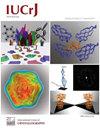通过结构特异性约束对x射线结构的量子化学方法进行基准测试。
IF 3.6
2区 材料科学
Q2 CHEMISTRY, MULTIDISCIPLINARY
引用次数: 0
摘要
制药行业需要对不精确的晶体结构(“增强”)进行快速、高效和准确的固态结构优化,以便进行后续的性能预测。单晶x射线、三维电子或粉末衍射的晶体结构广泛可用,但需要提高到相同的质量水平以进行比较研究。当理论水平相当,准确度和精密度都很高时,可以最好地计算出性质。此外,在药物研究中遇到的分子的大小和结构的复杂性也在增加。因此,需要有效的程序来处理无序结构和单位细胞的不对称单元中的几个分子。因此,我们研究了“分子簇”(MIC)计算是否[Dittrich et al.(2020)]。CrystEngComm 22, 7420-7431]可以达到全周期(FP)计算的精度。评估选定的量子力学方法。评价标准是22个极低温高质量结构的结构再现程度。计算效率也被考虑在内。一种评估量子力学预测准确性的新方法是在晶体学最小二乘改进中强制执行计算结构特异性约束。为了补充这种方法,还比较了计算结构和实验结构的均方根笛卡尔位移。分析表明:(a)在量子力学/分子力学(QM:MM)框架下的MIC DFT- d计算比早期的MIC GFN2-xTB计算提供了更好的约束和坐标,(b)在MIC QM:MM中增加QM基集的大小并没有系统地改善计算,(c) DFT泛函的选择不如基集的选择重要。总体而言,MIC计算是一种精确且计算效率高的固态结构优化工具,可以与FP计算相匹配,以增强实验结构。本文章由计算机程序翻译,如有差异,请以英文原文为准。
Benchmarking quantum chemical methods with X-ray structures via structure-specific restraints
Single-crystal X-ray structures measured at around 20 K to high resolution were refined with structure-specific restraints from quantum chemical molecule-in-cluster and full-periodic computations, which permits benchmarking levels of theory of varying sophistication. Restraints can then ‘augment’ low-quality crystal structures, with other possible applications.
There is a need for fast, efficient and accurate solid-state structure optimization for imprecise crystal structures (‘augmentation’) for subsequent property prediction in the pharmaceutical industry. Crystal structures from single-crystal X-ray, 3D electron or powder diffraction are widely available but require augmentation to the same quality level for comparative studies. Properties can be best calculated when the level of theory is alike and the accuracy, as well as the precision, are high. Moreover, the size of molecules and the complexity of structures encountered in pharmaceutical research are increasing. Efficient procedures are thus required that can also treat structures with disorder and several molecules in the asymmetric unit of the unit cell. Hence, we investigated whether ‘molecule-in-cluster’ (MIC) computations [Dittrich et al. (2020). CrystEngComm22, 7420–7431] can reach the accuracy of full-periodic (FP) computations. Selected quantum mechanical methods are assessed. The evaluation criterion is how well the structures of 22 very low temperature high-quality structures are reproduced. Computational efficiency is also considered. A novel approach to evaluating the accuracy of quantum mechanical predictions is enforcing computed structure-specific restraints in crystallographic least-squares refinements. To complement this approach, root mean square Cartesian displacements of computed and experimental structures were also compared. Analysis shows that (a) MIC DFT-D computations in a quantum mechanics/molecular mechanics (QM:MM) framework provide improved restraints and coordinates over earlier MIC GFN2-xTB computations, (b) increasing QM basis-set size in MIC QM:MM does not systematically improve computations, and (c) the choice of DFT functional is less important than the choice of the basis set. Overall, MIC computations are an accurate and computationally efficient tool for solid-state structure optimization that can match FP computations to augment experimental structures.
求助全文
通过发布文献求助,成功后即可免费获取论文全文。
去求助
来源期刊

IUCrJ
CHEMISTRY, MULTIDISCIPLINARYCRYSTALLOGRAPH-CRYSTALLOGRAPHY
CiteScore
7.50
自引率
5.10%
发文量
95
审稿时长
10 weeks
期刊介绍:
IUCrJ is a new fully open-access peer-reviewed journal from the International Union of Crystallography (IUCr).
The journal will publish high-profile articles on all aspects of the sciences and technologies supported by the IUCr via its commissions, including emerging fields where structural results underpin the science reported in the article. Our aim is to make IUCrJ the natural home for high-quality structural science results. Chemists, biologists, physicists and material scientists will be actively encouraged to report their structural studies in IUCrJ.
 求助内容:
求助内容: 应助结果提醒方式:
应助结果提醒方式:


